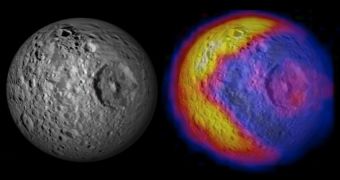In a recent flyby it conducted around the Saturnine moon Mimas, the NASA Cassini spacecraft managed to obtain the most detailed, high-resolution images of the space rock ever produced. The recent photos of the surface, combined with complex temperature maps, provide the most comprehensive view to date of the peculiar natural satellite. Researchers investigating the photos were surprised to find an old “friend” on the moon, the famous video game character Pac-Man. It appears to be eating one of its famous dot, in the temperature map that Cassini produced.
Some of the most interesting data collected by the spacecraft, in orbit around Saturn since July 2004, also reveal striking bands of light and dark in some crater walls, a finding that astronomers and planetary scientists say merits more analysis. “Other moons usually grab the spotlight, but it turns out Mimas is more bizarre than we thought it was. It has certainly given us some new puzzles,” says Cassini project scientist Linda Pilker, who is based at the NASA Jet Propulsion Laboratory, in Pasadena, California. The lab manages the Cassini mission.
The Pac-Man resemblance is only the latest in a row. The entire space rock looks like the Death Star of Star Wars fame, due to the enormous Herschel Crater that adorns its surface. The new temperature maps were collected using the composite infrared spectrometer aboard the space orbiter. The instrument is very precise, but the readings were also easy to collect due to the proximity of the flight. Cassini flew around Mimas on February 13, the JPL team says. The Pac-Man-like shape seen in the image has a temperature of about 92 Kelvin (minus 294 degrees Fahrenheit), whereas the cooler regions feature an average temperature of only 77 Kelvin (minus 320 degrees Fahrenheit). The “dot” the cosmic Pac-Man is eating is about 84 Kelvin (minus 310 degrees Fahrenheit).
“We suspect the temperatures are revealing differences in texture on the surface. It's maybe something like the difference between old, dense snow and freshly fallen powder,” says Cassini composite infrared spectrometer team member John Spencer. He holds an appointment at the Boulder, Colorado-based Southwest Research Institute (SwRI). What the science team operating the spacecraft is currently trying to figure out is why the sharp temperature differences exist that cause the Pac-Man to be so clearly visible.

 14 DAY TRIAL //
14 DAY TRIAL //